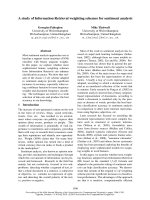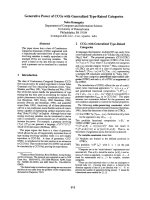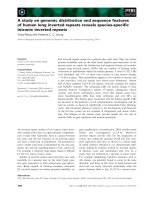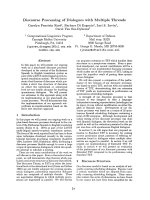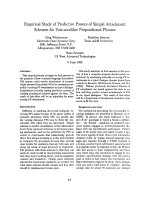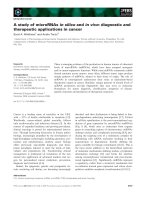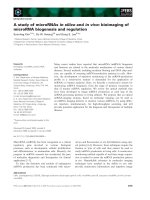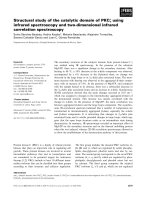Báo cáo khoa học: "Immunohistochemical study of constitutive neuronal and inducible nitric oxide synthase in the central nervous system of goat with natural listeriosis" potx
Bạn đang xem bản rút gọn của tài liệu. Xem và tải ngay bản đầy đủ của tài liệu tại đây (101.23 KB, 4 trang )
-2851$/# 2)
9HWHULQDU\#
6FLHQFH
J. Vet. Sci. (2000),1(2), 77–80
Immunohistochemical study of constitutive neuronal and inducible nitric
oxide synthase in the central nervous system of goat with natural listeriosis
Taekyun Shin
1-3
*
, Daniel Weinstock
1, 2
, Marlene D. Castro
1, 2
, Helene Acland
1, 3
, Mark Walter
1, 3
,
Hyun Young Kim
1, 3
and H.Graham Purchase
1, 3
Department of Veterinary Medicine, Institute for Life Science, BK 21, Cheju National University, Cheju 690-756, Korea
1
Pennsylvania Animal Diagnostic Laboratory System
2
Center for Veterinary Diagnostics and Investigation, Pennsylvania State University, University Park, PA., U.S.A.
3
Pennsylvania Veterinary Laboratory, Harrisburg, PA., U.S.A.
The expression of both constitutive and inducible forms of
nitric oxide synthase (NOS) was investigated by
immunohistochemical staining of formalin-fixed paraffin-
embedded sections in normal and Listeria monocytogenes-
infected brains of goats. In normal control goats, a small
number of neurons showed immunoreactivity of both
iNOS and nNOS, and the number of iNOS-positive
neurons was higher than the number of nNOS-positive
neurons. In natural listeriosis, listeria antigens were easily
immunostained in the inflammatory cells of
microabscesses. In this lesion, the immunoreactivity of
iNOS in neurons was more intense than the control, but
nNOS was not. In microabscesses, nNOS was weakly
visualized in macrophages and neutrophils, while iNOS
was expressed in macrophages, but not in neutrophils.
These findings suggest that normal caprine brain cells,
including neurons, constitutively express iNOS and
nNOS, and the expressions of these molecules is increased
in Listeria monocytogenes infections. Furthermore,
inflammatory cells, including macrophages, expressing
both nNOS and iNOS may play important roles in the
pathogenesis of bacterial meningoencephalitis in goat.
Key words:
nitric oxide synthase, goat, brain, listeriosis
Introduction
Nitric oxide (NO) is a readily diffusible, apolar gas,
synthesized from L-arginine by nitric oxide synthase
(NOS) [11-13]. The enzyme responsible for NO formation
exists in three forms: two constitutive forms, neuronal
NOS (nNOS) and endothelial NOS (eNOS), and inducible
NOS (iNOS) [13]. In the central nervous system tissues, all
major NOS isoforms are either constitutively expressed or
induced by the appropriate stimuli including autoimmune
encephalomyelitis [10]. Constitutive NOSs are most
important in the initial generation of NO in the central
nervous system (CNS), and therefore NO is important for
intracellular signaling and neurotransmission [1, 11]. Besides
its expected physiological role, NO is likely to be involved
in CNS disorders, including experimental autoimmune
encephalomyelitis [10], bacterial meningoencephalitis [8],
and viral encephalitis [6].
Listeriosis is one of the seasonal CNS diseases in
domestic animals including cattle, goats and sheep [2, 6].
L. monocytogens is known as one of the important human
pathogens, especially through meat contamination [2]. Goats
with natural listeriosis show circling behavior followed, in
most cases, by death. Encephalitic lesions are most severe
in the midbrain, less severe in the cerebellum, and rarely
occur in the cerebrum [3, 4, 14, 17]. Lesions in the
brainstem may or may not contain Listeria monocytogenes
antigens, but characteristically consist of inflammatory
cells, including neutrophils, macrophages, and some
lymphocytes, suggesting that inflammatory cells play an
important role in the brain tissue injury [8, 9]. These cell
types are also associated with the secretion of pro-
inflammatory cytokines and the generation of toxic free
radicals, including nitric oxide, which possibly play roles
either in the elimination of infected bacteria or the damage
of host tissues.
There is general agreement that a significant increase of
iNOS is important in the pathogenesis of natural listeriosis
in the brains of cattle and goats [6]. However, constitutive
nNOS has not been well elucidated in bacterial
meningoencephalitis in goat. The aim of this study was
therefore to examine the expression of nNOS in the brain
of goats with natural listeriosis, and to compare the
*Corresponding author
Phone: +82-64-754-3363; Fax: +82-64-756-3354
E-mail:
78 Taekyun Shin et al.
immunoreactivity of both iNOS and nNOS in the same
lesion.
Materials and Methods
Selection of cases
Two cases of goats with natural listeriosis (6 months old
and 2.5 years old) (Cases 1 and 2) and two controls (1 and
2 years old) (Cases 3 and 4) were studied. All the brains
with natural listeriosis used in this study were from
animals submitted for necropsy to the Pennsylvania
Animal Diagnostic Laboratory System (PADLS) in
Harrisburg, Pennsylvania. In all the selected midbrains, L.
monocytogenes was confirmed by immunohistochemistry
using the antisera described below. Neither direct culture
of bacteria nor cold enrichment culture were always
successful in isolating L. monocytogenes from tissue,
although the tissue was positive by immunohistochemistry
[7]. Two caprine brains were used as controls. The control
animals had no inflammation in the brain by histological
examination.
Histopathological examination
Specimens, including brainstem, cerebellum, and cerebrum,
were fixed in 10% buffered formalin, embedded in
paraffin, sectioned at 4 microns, and stained with
hematoxylin and eosin by routine histopathologic
techniques. Brainstem sections of paraffin-embedded
tissues from animals with characteristic histopathologic
lesions of suppurative encephalitis were used for the NOS
study.
Antisera and reagents
The antisera used in this study were: rabbit polyclonal
antiserum against L. monocytogenes (Listeria O antiserum
poly, serotypes 1 and 4, Difco, Detroit, MI), rabbit anti-
glial fibrillary acidic protein (GFAP) (Sigma, St. Louis,
MO), rabbit anti-iNOS (Sigma), rabbit anti-nNOS
(Sigma). Immunoperoxidase staining was done using the
labeled [strept]avidin-biotin (LAB-SA) procedure (Zymed
Laboratories, San Francisco, CA).
Immunohistochemistry for
L
.
monocytogenes
, GFAP,
iNOS, and nNOS
Serial sections of midbrain, cerebrum, and cerebellum
were deparaffinized and blocked with 3% hydrogen
peroxide in distilled water for 10 minutes. After washing
with phosphate buffer, sections were blocked, and the
primary antisera were reacted for 60 min, followed by
biotinylated antisera (Zymed) for 15 minutes and
[strept]avidin- biotin peroxidase (Zymed) for 15 minutes.
Staining was done using a LAB-SA Kit (Zymed)
according to the manufacturers instructions. The dilutions
of primary antisera used in this study were as follows: anti-
L. monocytogenes 1 : 1000, anti-GFAP 1 : 1000, anti-
iNOS 1 : 100, anti-nNOS 1 : 100, and anti-nitrotyrosine
1 : 1000. For the negative control, primary antiserum was
omitted or was replaced with normal rabbit sera (Zymed).
All incubations were at 36
o
C using a Microprobe Staining
System (Fisher Biotech, Fisher Scientific, St. Louis, MO).
After immunoreaction was complete, sections were
counterstained with hematoxylin and mounted with
Clearmount (Zymed).
Results
Constitutive expression of nNOS and iNOS in the non-
neurological control brain
Both nNOS and iNOS immunoreactivity was recognized
in the brain of control goats. No inflammatory cells were
found in the brain sections of control animals. The
immunoreactivity of iNOS was recognized in the
occasional neurons (Fig. 1, A) and choroid plexus cells
(Fig. 1, B), but was rare in neuroglial cells. nNOS was also
immunoreactive in some neurons (Fig. 1, C) and choroid
plexus cells in the same lesion. In the negative control, no
immunostaining was seen in sections where primary
antiserum was omitted or rabbit anti-Listeria monocytogenes
antisera substituted (Fig. 1, D). These findings suggest that
neuronal cells including neurons, choroid plexus cells and
some neuroglial cells may constitutively express both
iNOS and nNOS in the non-neurological state.
Fig. 1.
Immunohistochmical staining of iNOS (A, C) and nNOS
(B) in control brains with non-neurological cases. Some neurons
constitutively express both iNOS (A) and nNOS (B) in the
brainstem. Choroid plexus cells were also positive for iNOS (C).
D is a negative immunostaining control which omits primary
antisera. A - D, counterstained with hematoxylin. Magnification
A and B,
×
66. C and D,
×
132.
Immunohistochmical study of nitric oxide synthase in the central nervous system of goat 79
Enhanced expression of nNOS and iNOS in
L
.
mon
oc
ytogenes
-infected brain
At necropsy, case 1 (6 months old) showed focal and acute
bronchopneumonia, enlargement of the mesenteric lymph
nodes and diffuse acute conjunctivitis. Case 2(2 years old)
showed dehydration, myositis and pulmonary edema.
Histopathologically, brain tissues from animals with
listeriosis showed typical suppurative meningoencephalitis
in the midbrain (Fig. 2, A), and occasionally in the
cerebellum. The lesions consisted of microabscesses
containing neutrophils, and perivascular cuffing of
lymphocytes and macrophages. L. monocytogenes antigen
was commonly found in microabscesses (Fig. 2, B) and
perivascular cuffs. Occasionally single positive-staining
bacteria were found in the neuronal processes.
Both nNOS and iNOS immunoreactivity were found in a
proportion of the neurons in the brainstem and the staining
pattern was similar to those of control brains with non-
neurological diseases. In the microabscesses, iNOS was
recognized in inflammatory cells (mainly macrophages) in
the microabscesses, and some astrocytes (identical in
morphology and GFAP immunostaining) surrounding the
microabscesses (Fig. 2, C). The iNOS-immunoreactivity in
inflammatory cells was largely consistent with that of
nNOS (Fig. 2, D). In the white matter adjacent to
ventricles, both nNOS- and iNOS-positive glial cells were
increased compared with the control animals.
Discussion
This study showed that some neurons in normal control
goats expressed both iNOS and nNOS, and that both
constitutive nNOS and iNOS in neurons increased when
bacterial encephalitis occurred. This is the first study of
NOS expression in the goat brain with listeriosis.
The involvement of iNOS in bovine and caprine
listeriosis has been reported previously, and the increased
expression of iNOS and the resultant NO generation were
confirmed in brains with listeriosis and in cultured
macrophages from the Listeria-affected cattle [6]. This
study is in part consistent with the previous study[6], in
which some inflammatory macrophages, but neutrophils
not, express iNOS in microabscesses. This study reported
here are quite different in terms of neuronal staining for
iNOS in caprine listeriosis compared with the previous
bovine study [6]. We prefer to postulate that the
differences are due to the different detection system of
immunostaining and different sources of primary antisera.
We used a polyclonal antisera (rabbit anti-iNOS, and rabbit
anti-nNOS from Sigma).
The increased expression of iNOS in brain cells, i.e.,
neurons versus astrocytes, seen in this study suggests that
normal neurons may constitutively express iNOS. We
postulate that nitric oxide generated endogenously via
either iNOS or nNOS functions as a neuroprotectant
against neurotropic injury, because iNOS is known as an
endogenous neuroprotectant in traumatic brain injury [18].
The important finding in this study is that nNOS is not
only expressed in some neurons, but also in hematogenous
macrophages. As far as nNOS expression in neutrophils in
pathologic tissues is concerned, this study is a first
confirmation, and is supported by the detection of nNOS
mRNA in hematogenous cells including macrophages, T
cells [15, 16], and neutrophils in vitro [5]. The functional
role of nNOS in this disease remains to be studied. In
addition, Wu et al.[19] reported that nNOS may play a role
in the pathogenesis of arthritis and spinal cord inflammation.
In summary, these results suggest that both nNOS and
iNOS are constitutively expressed in brain cells, including
neurons and some neuroglial cells, and that in the brains of
goats with natural listeriosis their expression increases in
response to exogenous injury such as L. monocytogenes
infection. In natural caprine listeriosis, nitric oxide
produced by either nNOS or iNOS in neutrophils and
macrophages and by brain cells may play an important role
Fig. 2.
Histology and immunostaining of caprine brains with
natural listeriosis. A: Brain of a goat with listeriosis showing
meningoencephalitis. H-E staining, X66. B: Many dot-type
bacteria (arrows) with immunoreactivity to anti-Listeria
monocytogenes antisera were observed in inflammatory
microabscesses. Counterstained with hematoxylin. Magnification:
×
132. C: Immunohistochemical staining of inducible NOS in
the caprine brain with natural listeriosis shows that iNOS
immunoreactivity was recognized in neurons, some
inflammatory cells in perivascular cuffings. Counterstained
with hematoxylin, Magnification:
×
132. D: Immunostaining
of neuronal NOS in brain sections of goats with natural
listeriosis. nNOS immunoreactivity was seen in some
inflammatory cells. Some cells show the typical morphology
of macrophages in perivascular cuffs and microabscesses.
Counterstained with hematoxylin, Magnification:
×
132.
80 Taekyun Shin et al.
in eliminating Listeria monocytogenes as well as in the
destruction of brain tissue.
Acknowledgments
The authors greatly appreciate Carol Robinson for
technical support. The authors also thank Dr. T. W. Jungi,
Institute of Veterinary Virology and Animal Pathology,
University of Bern, Switzerland for critical discussion of
this manuscript. This work is supported by Korea Research
Foundation Grant (KRF
−
2000
−
041
−
G00118)
References
1.
Bredt, D.S and Snyder, S.H
. Nitric oxide, a novel neuronal
messenger. Neuron 1992,
8
, 3-11.
2.
Cooper, J. and Walker, R.D.
Listeriosis. Vet. Clin. North.
Am. Food Anim. Pract. 1998,
14
, 113-125.
3.
Charlton, K.M. and Garcia, M.M.
Spontaneous listeric
encephalitis and neuritis in sheep. Light microscopic studies.
Vet. Pathol. 1997,
14,
297-313.
4.
Dramsi, S., Levi, S., Triller, A. and Cossart, P.
Entry of
Listeria monocytogenes into neurons occurrs by cell-to-cell
spread: an in vitro study. Infect. Immun. 1998,
66,
4461-
4468.
5.
Greenberg, S.S., Ouyang, J., Zhao, X. and Giles, T.D.
Human and rat neutrophils constitutively express neuronal
nitric oxide synthase mRNA. Nitric Oxide 1998,
2,
203-212.
6.
Hooper, D.C., Ohnishi, S.T., Kean, R., Numagami, Y.,
Dietzschold, B. and Koprowski, H.
Local nitric oxide
production in viral and autoimmune disease of the central
nervous system. Proc. Natl. Acad. Sci. U.S.A. 1995,
92,
5312-5316.
7.
Johnson, G.C., Fales, W.H., Maddox, C.W. and Ramos-
Vara, J.A
. Evaluation of laboratory test for confirming the
diagnosis of encephalitic listeriosis in ruminants. J. Vet.
Diagn. Invest. 1995,
7
, 223-228.
8.
Jungi, T.W., Pfister, H., Sager, H., Fatzer, R., Vandevelde,
M. and Zurbriggen, A.
Comparison of inducible nitric
oxide synthase expression in the brain of Listeria
monocytogenes-infected cattle, sheep and goats and in
macrophages stimulated in vitro. Infect. Immun. 1997,
65
,
5279-5288.
9.
Krueger, N., Low, C. and Donachie, W.
Phenotypic
characterization of the cells of the inflammatory response in
ovine encephalitic listeriosis. J. Comp. Pathol. 1995,
113
,
263-275.
10.
Kim, S., Moon, C., Wie, M., Kim, H., Tanuma, N.,
Matsumoto, Y. and Shin, T.
Enhanced expression of
constitutive and inducible forms of nitric oxide synthase in
autoimmune encephalomyelitis. J. Vet. Sci., 2000,
1
, 11-17.
11.
Moncada, S., Palmer, R.M.J. and Higgs, E.A.
Nitric
oxide: physiology, pathophysiology, and pharmacology.
Pharmacol. Rev., 1991,
43
, 109-134.
12.
Murphy, S., Simmons, M.L., Agullo, L., Carcia, A.,
Feinstein, D.L., Galea, E., Reis, D.J., Minc-Golomb, D.
and Schwartz, J.P.
Synthesis of nitric oxide in CNS glial
cells. T.I.N.S. 1993,
16
, 323-328.
13.
Nathan, C. and Xie, Q W
. Nitric oxide synthases: Roles,
tolls and controls. Cell 1994,
78
, 915-918.
14.
Otter, A. and Blackmore, W.F
. Observation on the
presence of Listeria monocytogenes in axons. Acta
Microbiol. Hung. 1989,
36
, 125-131.
15.
Reiling, N., Ulmer, A.J., Duchrow, M., Ernst, M., Flad,
H.D. and Hauschildt, S.
Nitric oxide synthase: mRNA
expression of different isoforms in human monocytes/
macrophages. Eur. J. Immunol. 1994,
24
, 1941-1944.
16.
Reiling, N., Kroncke, R., Ulmer, A.J., Gerdes, J., Flad,
H.D. and Hauschildt, S.
Nitric oxide synthase: expression
of the endothelial, Ca2+/calmodulin-dependent isoform in
human B and T lymphocytes. Eur. J. Immunol. 1996,
26
,
511-516.
17.
Rouquette, C. and Berche, P.
The pathogenesis of infection
by Listeria monocytogenes. Microbiologia 1996,
12
, 245-
258.
18.
Sinz, E.H., Kochanek, P.M., Dixon, C.E., Clark, R.S.,
Carcillo, J.A., Schiding, J.K., Chen, M., Wisniewski,
S.R., Carlos, T.M., William, D., DeKosky, S.T., Watkins,
S.C., Marion, D.W. and Billiar, T.R.
Inducible nitric oxide
synthase is an endogenous neuroprotectant after traumatic
brain injury in rats and mice. J. Clin. Invest. 1999,
104
, 647-
656.
19.
Wu, J., Lin, Q., Lu, Y., Willis, W.D. and Westlund, K.N.
Changes in nitric oxide synthase isoforms in the spinal cord
of rat following induction of chronic arthritis. Exp. Brain
Res. 1998,
118
, 457-465
